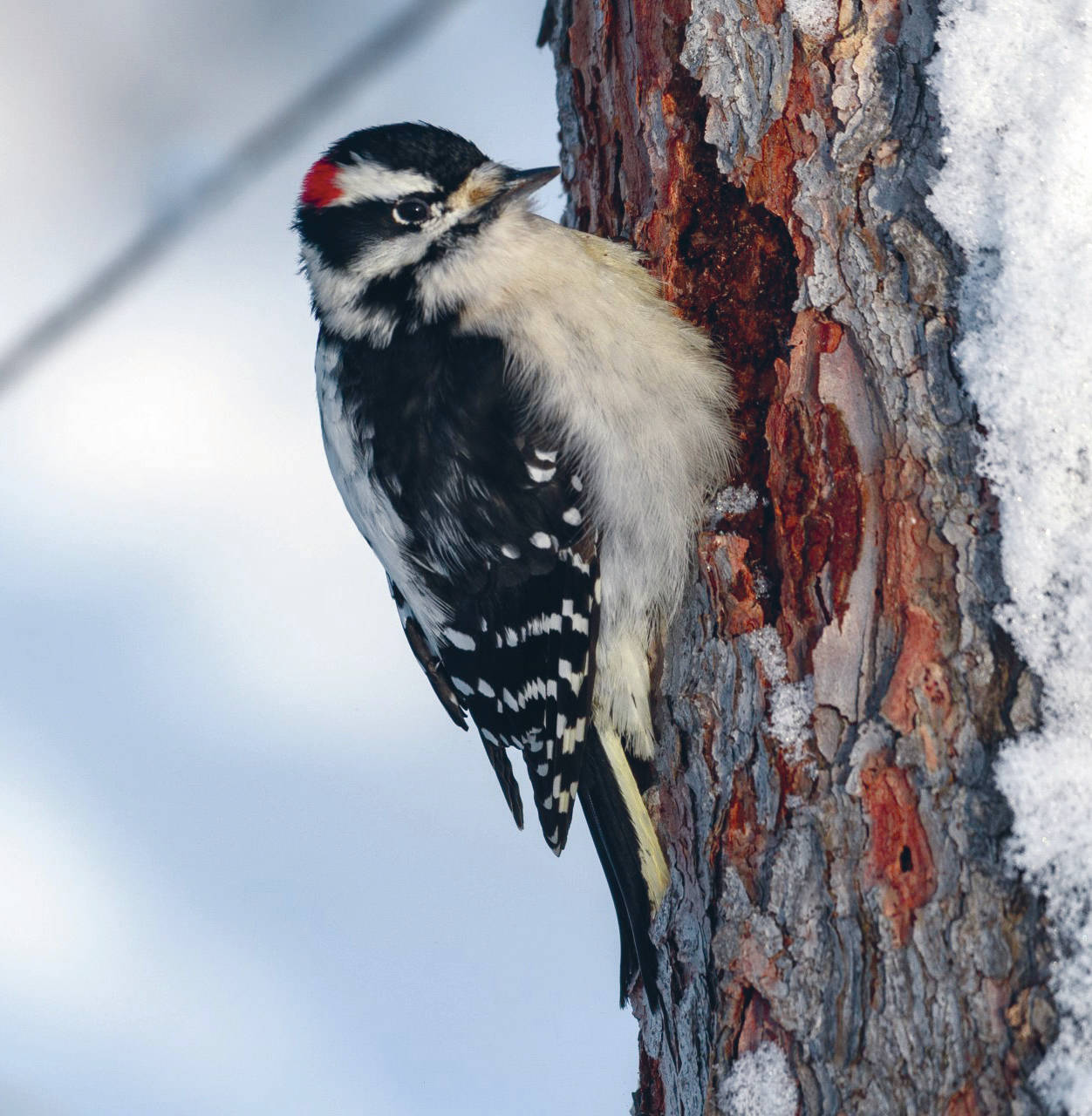On a recent sortie looking for grouse in the spruce forest of the northern Kenai Peninsula, I heard what sounded to me like a squeaky toy. I stopped and eventually found the bird making the sound.
Normally the great horned owl that I’d seen earlier would have been the highlight observation for the day. But for some reason a different bird, a common one at that, stole the show.
This little bird is so common that it rarely draws much more than momentary acknowledgement. But for whatever reason, I sat down and watched this little downy woodpecker going about its daily business.
The more I watched this little woodpecker, the more I found myself increasingly curious about the uniqueness of this “common” species. Like most things, the downy woodpecker has its own distinctive and veiled magnificence, if one stops to appreciate it for what it is.
Admittedly, with the black back and white underside typical of several other woodpecker species, their plumage is not particularly flashy nor remarkable. At least not at first glance. But upon closer examination the interesting and unique patterns on this little bird become more apparent.
The black wings are adorned with bold white spots that give it a mottled look from a distance. The head is striped with stark black and white lines that, on adult males, sharply contrast with a small patch of bright red feathers on the nape. A long, white strip of soft, white feathers running down the back gives the downy woodpecker its name.
What they may lack in extravagant or ornate plumage, however, they certainly make up for in behavior. The first thing that I noticed when I sat down to watch this tiny woodpecker was its energetic and tireless foraging. This thing just didn’t stop moving, ever.
Not only that, but it seemed to actually be enjoying its fast-paced lifestyle. Well-known ornithologist John Audubon possibly best described its energetic lifestyle when he wrote that the downy woodpecker “is perhaps not surpassed by any of its tribe in hardiness, industry, or vivacity.”
The downy woodpecker is the smallest of North America’s 23 native woodpecker species. But being the smallest comes with some advantages. Downies can forage where larger and heavier woodpeckers cannot. Their small size allows them to forage on the thinner outermost branches of trees, treetops, and even in shrubs and bushes in the forest understory.
They are even small enough that they can forage upside down, using their relatively small, fine-tipped beak to exploit smaller insect tunnels, and plant galls, and to pick tiny insects and their eggs from leaves and stems.
The diet of downy woodpeckers primarily consists of insects, but they will exploit any potential food source available. With more than 75% of their diet consisting of insects, common foods include a variety of insects, larvae, caterpillars, weevils, beetles and ants.
Key foods include bark and other wood-boring beetles and their larvae, which live inside wood and tree bark. Their proclivity toward eating bark beetles, and a variety of other insect species that are considered to be forest pests, means that the downies play an important role in the natural maintenance of forest health.
The Kenai Peninsula has recently experienced warmer and drier summers, conditions that prime our spruce forests for spruce beetle outbreaks. The damage done to the trees is apparent in many areas on the Kenai Peninsula but these dead and dying trees also provide increased food and nesting cavities for downies.
Numerous studies document dramatic increases in downy woodpecker abundance following bark beetle outbreaks. Downy woodpeckers on the Kenai have undoubtedly benefited greatly from recent spruce bark beetle outbreaks.
Downies are highly flexible and will also supplement their insect diets with a variety of alternate foods like berries, seeds and other plant materials. It’s no surprise then, that downies are the most likely woodpecker that people will see at their bird feeders on the Kenai Peninsula.
If people want to attract downies to backyard feeders, foods like suet are a favorite, but they will also come in to feeders with peanut butter, black oil sunflower seeds, and other seeds and nuts. To reduce competition with other species at feeders, people can put out upside-down suet feeders, where downies can easily feed but many other species cannot.
Downy woodpeckers are not only small and hyperactive, but they are also remarkably smart. Downies have been documented to follow white breasted nuthatches to their seed caches and raid them.
They are also known to follow larger woodpeckers around and investigate their excavations, letting their larger neighbors do the hard work and taking advantage of any smaller insects that the larger woodpeckers might have missed or couldn’t reach. They will even join up with flocks of other bird species and follow them to the best foraging areas.
Their intelligence and ability to take advantage of all opportunities seems to have worked out well for them. Downies are common throughout most of North America. Basically, if you are in North America and there are trees around you, there’s a good chance that a downy woodpecker is nearby.
They are also a hardy species and, with the ability to find food year-round in most areas, they’ll tough out the long, cold winter that drives other birds south to warmer climes.
The next time you’re out for a walk in the woods, don’t miss the opportunity and take a few minutes to watch one of these industrious little woodpeckers. You won’t be disappointed.
Dom Watts is a Wildlife Biologist at Kenai National Wildlife Refuge. Find more Refuge Notebook articles (1999–present) at https://www.fws.gov/Refuge/Kenai/community/Refuge_notebook.html.
By DOM WATTS
Kenai National Wildlife Refuge

